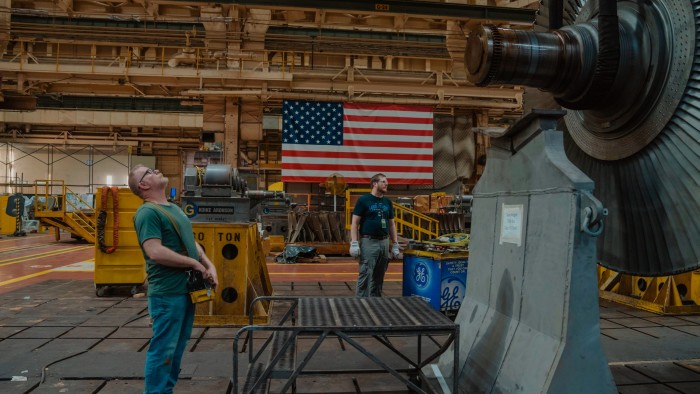In a corner of the American rustbelt, factory workers at GE’s former power business are betting a revival driven by the AI revolution will survive the global trade war and supply chain havoc unleashed by Donald Trump.
GE Vernova, formed a year ago after the conglomerate’s break-up, is investing nearly $600mn to expand its former headquarters in Schenectady, in New York state, and other sites to make equipment for gas-fired power plants and to help overhaul the US’s ageing electricity grid.
The strategy aligns with the Trump administration’s push to reshore manufacturing and break the US’s reliance on overseas supply chains — especially China.
It is also part of a broader pivot to natural gas in an economy where artificial intelligence data centres’ are expected to need huge volumes of reliable, round-the-clock electricity — and the fossil fuels promoted by President Trump over renewables can supply it.
These trends have supercharged GE Vernova’s share price, which tripled to a high of $438 in January following its April 2024 spin-off, after repeated losses from its troubled wind energy business.

But analysts warn that the post-spin off euphoria is under threat, as the efficiency gains made by China’s DeepSeek AI model leave investors wondering if the technology will need as much power as thought.
GE Vernova’s shares have fallen by 26 per cent since hitting a peak on January 23, when Trump unveiled his $500bn Stargate project for AI.
“If the AI hype cycle comes down to earth . . . the stock is going to feel pressure,” said Brett Castelli, an equity analyst at Morningstar Research.
In addition to doubts over power projections, Trump’s attacks on renewable energy and his aggressive trade war have become potential problems for the company’s wind business and supply chains.
After two decades of stagnation, US electricity consumption has risen to record highs and is expected to grow another 16 per cent by 2029, driven by AI data centres and onshoring, according to think-tank Grid Strategies.

That market dynamic has transformed GE Vernova’s gas turbine business. Orders for turbines doubled last year and the company is fully booked into 2028.
Its electrification business, which produces grid equipment, has seen orders rise almost 20 per cent year-over-year. “We’re going into an investment supercycle,” Scott Strazik, GE Vernova’s chief executive, said in an interview last month.
But the demand outlook is fraught with risk given the uncertainties around AI.
The Electric Power Research Institute, for example, projects data centres could consume as little as 4.6 per cent of US electricity by 2030, up from just 4 per cent. But it also says the share could reach nearly 10 per cent.
Meanwhile, the Department of Energy suggests demand could triple by 2028.
“GE Vernova is a play on the electrification of the economy and rising electricity demand . . . The variable that has the widest range of outcomes is AI,” said Castelli.

Its wind business has also hit some turbulence. Two years ago under the renewables-friendly Biden administration, the company planned to turn Schenectady into a growth centre for the industry.
But it has been a lossmaking part of the business, under pressure from supply chain constraints, high interest rates, and a disastrous offshore wind blade collapse last summer due to a manufacturing deviation.
Now Trump’s permitting freeze and effort to scrap the Inflation Reduction Act, Biden’s signature climate law extending subsidies for wind developers, has left the entire offshore wind sector in peril.
Just last week, the administration scrapped a huge $5bn offshore wind project from Equinor that was already in development.

GE Vernova’s orders for onshore and offshore wind turbines nearly halved last year, and the company announced it was no longer taking new offshore orders and downsizing the business.
“The moment of growth inflection is very hard to call,” Strazik told the FT.
Trump’s tariff war on countries following his April 2 “liberation day” announcement have also thrown the supply chain of US manufacturers into uncertainty.
Strazik and other GE Vernova executives, however, dismissed concerns about the future, pointing to substantial power demand growth beyond the US and AI data centres, a continued global transition to lower carbon energy, and their investments in the US supply chain.
“This is where it helps to be a US based company,” Strazik said. “We’ll continue to localise our businesses to the extent that the geopolitical supply chains are complicated.”


